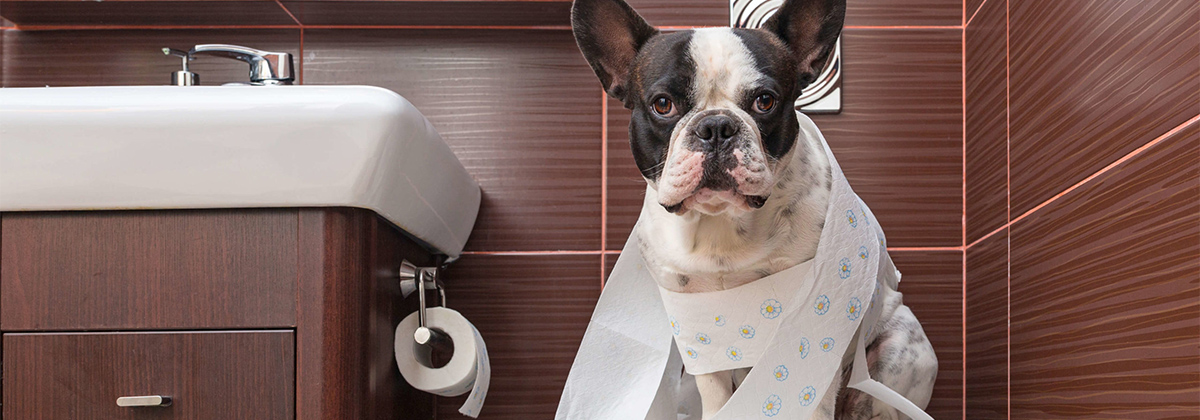17 Feb Dog Diarrhea; Causes and Treatment (Part 2)
Diarrhea in dogs is a symptom of gastrointestinal disease that can occur for a variety of reasons. Some of these reasons are dangerous and some of them are normal. In the first part, we explained about the appearance, color and smell of normal dog feaces and their abnormal condition with diarrhea. We also talked about the emergency treatment. We also mentioned the different types of diarrhea and the main reasons for its occurrence. In this section we will talk about the symptoms, their dangerous type, color differences and the reasons for each type.
Dangerous diarrhea in some dogs
Diarrhea in small breeds, young dogs and puppies, older dogs and dogs with other underlying diseases or taking medication can cause more problems.
Symptoms of the disease
The following are among the types of symptoms of dog disease, and if you see any of them, you must inform the veterinarian immediately:
- Decreased appetite and drinking water
- Excessive weakness and lethargy
- Pain and discomfort
- Blood in the stool (in the form of black stools or visible blood stains)
- Dog vomiting
- Reduce or stop dog urination
Differences in the colour of diarrhea and the reasons for each
In general, the colour of dog feces is greatly influenced by the dog’s food and diet. However, other things change the colour of the stool that you should pay attention to, especially when you have diarrhea. If your dog has this problem, it’s better to inform the veterinarian about the colour of the dog’s diarrhea.
Yellow diarrhea
In most cases, yellow diarrhea occurs when the dog owner starts giving the dog mixed foods such as rice and chicken. Rice and chicken are light white and, when combined with yellow mucus in the gastrointestinal tract, cause the stool to turn yellow. But yellow diarrhea can be a sign of a more serious problem, such as:
- Coccidia
- Overgrowth of bacteria
- Liver disease
- Insufficiency of bile
Red diarrhea
Usually, when dogs have diarrhea, a small streak of blood may be seen in the stool. But if you constantly see blood in your dog’s stool or the blood turns the stool red and bloody, you must consult a veterinarian. Bloody diarrhea or hematopoiesis is usually caused by colon problems or colitis. This problem happens when small blood vessels in the lower part of the dog’s digestive tract rupture and some blood are spilled into the dog’s stool. The small amount of blood in the stool isn’t a big concern and you can talk to your veterinarian about it. But if the predominant colour of the stool is red, you should take the dog to the vet immediately. Some of the causes of redness and bloody diarrhea in dogs are:
- Parvovirus in dogs (especially in puppies)
- Bacterial infections
- Inflammatory bowel disease (gastroenteritis) or colitis
Black diarrhea
Black diarrhea or melena occurs when blood is already digested and enters the stool. The stool is similar in colour to the stools of newborn dogs and puppies and may have a black or green background. Melena is commonly seen in cases such as bleeding from stomach ulcers or eating foreign objects. Some of the causes of black diarrhea are :
- Different types of dog kidney disease
- Pancreatitis
- Parasites
- Bleeding in the upper gastrointestinal tract
Green diarrhea
Green diarrhea can also occur in puppies and adult dogs and can be due to one of the following
- Gastrointestinal hypomotility
- Gallbladder disease
- Eating lots of fresh grass
Gray diarrhea
Sometimes the diarrhea is gray and dark in colour and has a greasy state. The most common causes of gray stools are:
- Pancreatic problems such as exocrine pancreatic insufficiency
- Gallbladder diseases
- Parasites
Blue diarrhea
Blue is a very dangerous sign and is considered an emergency. Because the wrong dog swallowed rat poison (usually blue) or a toy. In these cases, quickly pour some diarrhea samples into a plastic bag and take the samples immediately to the veterinarian.
Dog phlegm diarrhea; The presence of mucus in diarrhea
Mucus or phlegm is a viscous fluid that covers the walls of the gastrointestinal tract, making it easier to move and pass stool. Therefore, small amounts of mucus may always be present in dog feces; But if the dog has diarrhea and there are large and visible amounts of mucus with it, it isn’t good. You should immediately inform the veterinarian. Some possible causes of canine diarrhea include:
- Dog parasites
- Sudden change in the dog’s diet
- Inflammatory bowel disease (usually accompanied by vomiting)
- Gastroenteritis or gypsy




Sorry, the comment form is closed at this time.